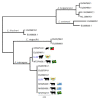Exposure and Carriage of Pathogenic Leptospira in Livestock in St. Croix, U.S. Virgin Islands
- PMID: 34073665
- PMCID: PMC8163180
- DOI: 10.3390/tropicalmed6020085
Exposure and Carriage of Pathogenic Leptospira in Livestock in St. Croix, U.S. Virgin Islands
Abstract
From 2019-2020, the Virgin Islands Department of Health (VIDOH) investigated potential animal reservoirs of Leptospira spp., the pathogenic bacteria that cause leptospirosis. We examined Leptospira exposure and carriage in livestock on the island of St. Croix, United States Virgin Islands (USVI). We utilized the microscopic agglutination test (MAT) to evaluate the sera, and the fluorescent antibody test (FAT), real time polymerase chain reaction (rt-PCR), and bacterial culture to evaluate urine specimens from livestock (n = 126): 28 cattle, 19 goats, 46 pigs, and 33 sheep. Seropositivity was 37.6% (47/125) with agglutinating antibodies to the following serogroups identified: Australis, Djasiman, Icterohaemorrhagiae, Ballum, Sejroe, Cynopteri, Autumnalis, Hebdomadis, Pomona, Canicola, Grippotyphosa, and Pyrogenes. Urine from 4 animals (4.0%, 4/101) was positive by rt-PCR for lipL32: 2 sheep, 1 goat, and 1 bull. Sequencing of secY amplicons identified L. interrogans in 1 sheep and 1 bull. Livestock in USVI harbor pathogenic Leptospira bacteria and could play a role in the zoonotic cycle of leptospirosis.
Keywords: bacterial disease; leptospirosis; livestock; zoonoses.
Conflict of interest statement
The authors declare no conflict of interest. The funders had no role in the design of the study; in the collection, analyses, or interpretation of data; in the writing of the manuscript, or in the decision to publish the results.
Figures
Similar articles
-
Mongooses (Urva auropunctata) as reservoir hosts of Leptospira species in the United States Virgin Islands, 2019-2020.PLoS Negl Trop Dis. 2021 Nov 15;15(11):e0009859. doi: 10.1371/journal.pntd.0009859. eCollection 2021 Nov. PLoS Negl Trop Dis. 2021. PMID: 34780473 Free PMC article.
-
Seroprevalence and renal carriage of pathogenic Leptospira in livestock in Cotonou, Benin.Vet Med Sci. 2024 May;10(3):e1430. doi: 10.1002/vms3.1430. Vet Med Sci. 2024. PMID: 38533755 Free PMC article.
-
Leptospira serology in small ruminants on St. Croix, U.S. Virgin Islands.Ann N Y Acad Sci. 1992 Jun 16;653:168-71. doi: 10.1111/j.1749-6632.1992.tb19640.x. Ann N Y Acad Sci. 1992. PMID: 1626866
-
A review of leptospirosis in Malaysia.Vet Res Commun. 1988;12(2-3):179-89. doi: 10.1007/BF00362799. Vet Res Commun. 1988. PMID: 3055663 Review.
-
Epidemiology of Leptospirosis: The First Literature Review of the Neglected Disease in the Middle East.Trop Med Infect Dis. 2022 Sep 24;7(10):260. doi: 10.3390/tropicalmed7100260. Trop Med Infect Dis. 2022. PMID: 36288001 Free PMC article. Review.
Cited by
-
Seroprevalence, distribution, and risk factors for human leptospirosis in the United States Virgin Islands.PLoS Negl Trop Dis. 2022 Nov 15;16(11):e0010880. doi: 10.1371/journal.pntd.0010880. eCollection 2022 Nov. PLoS Negl Trop Dis. 2022. PMID: 36378681 Free PMC article.
-
Assessing rodents as carriers of pathogenic Leptospira species in the U.S. Virgin Islands and their risk to animal and public health.Sci Rep. 2022 Jan 21;12(1):1132. doi: 10.1038/s41598-022-04846-3. Sci Rep. 2022. PMID: 35064157 Free PMC article.
-
Mongooses (Urva auropunctata) as reservoir hosts of Leptospira species in the United States Virgin Islands, 2019-2020.PLoS Negl Trop Dis. 2021 Nov 15;15(11):e0009859. doi: 10.1371/journal.pntd.0009859. eCollection 2021 Nov. PLoS Negl Trop Dis. 2021. PMID: 34780473 Free PMC article.
-
Leptospira borgpetersenii serovar Hardjo and Leptospira santarosai serogroup Pyrogenes isolated from bovine dairy herds in Puerto Rico.Front Vet Sci. 2022 Nov 17;9:1025282. doi: 10.3389/fvets.2022.1025282. eCollection 2022. Front Vet Sci. 2022. PMID: 36467637 Free PMC article.
-
The role of small ruminants in the epidemiology of leptospirosis.Sci Rep. 2022 Feb 9;12(1):2148. doi: 10.1038/s41598-022-05767-x. Sci Rep. 2022. PMID: 35140240 Free PMC article.
References
-
- Centers for Disease Control and Prevention (CDC) National Notifiable Infectious Diseases and Conditions, United States Annual Tables, Annual Data for 2018, Table 2h. [(accessed on 3 May 2021)]; Available online: https://wonder.cdc.gov/nndss/nndss_annual_tables_menu.asp.
-
- Centers for Disease Control and Prevention (CDC) Leptospirosis: Risk of Exposure. [(accessed on 3 May 2021)]; Available online: https://www.cdc.gov/leptospirosis/exposure/index.html.
-
- Marinova-Petkova A., Guendel I., Strysko J.P., Ekpo L.L., Galloway R., Yoder J., Kahler A., Artus A., Hoffmaster A.R., Bower W.A., et al. First Reported Human Cases of Leptospirosis in the United States Virgin Islands in the Aftermath of Hurricanes Irma and Maria, September–November 2017. Open Forum Infect. Dis. 2019;6:ofz261. doi: 10.1093/ofid/ofz261. - DOI - PMC - PubMed
-
- Artus A., Cossaboom C., Haberling D., Sutherland G., Galloway R., Villarma A., Browne A.S., Carillo M., Delgado D., Doyle J., et al. Seroprevalence of human leptospirosis in the U.S. Virgin Islands; Proceedings of the 11th International Leptospirosis Conference; Vancouver, BC, Canada. 8–12 July 2019; poster 33.
Grants and funding
LinkOut - more resources
Full Text Sources
Miscellaneous


